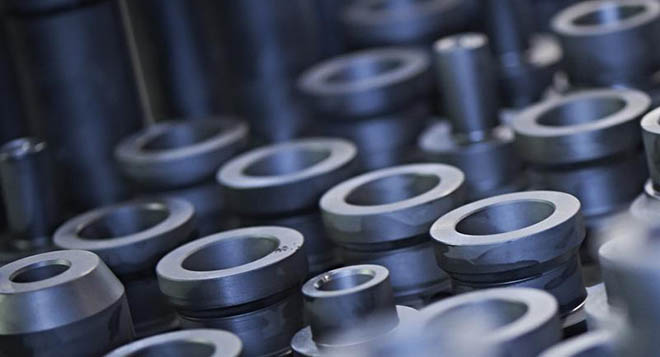Carburising is a thermochemical process in which carbon is diffused into the surface of low carbon steels to increase the carbon content to sufficient levels so that the surface will respond to heat treatment and produce a hard, wear-resistant layer. There are three types of carburising commonly used:
- gas carburising
- liquid carburising (or cyaniding)
- solid (pack) carburising
All three processes rely on the transformation of austenite into martensite on quenching. The increase in carbon content at the surface must be high enough to give a martensitic layer with sufficient hardness, typically 700HV, to provide a wear-resistant surface. The required carbon content at the surface after diffusion is usually 0.8 to 1.0%C. These processes can be carried out on a wide range of plain carbon steels, alloy steels and cast irons where the bulk carbon content is a maximum of 0.4% and usually less than 0.25%. Incorrect heat treatment can lead to oxidation or de-carburisation. Although a relatively slow process, carburising can be used as a continuous process and is suitable for high volume, surface hardening.
Gas carburising
In gas carburising, the component is held in a furnace containing an atmosphere of methane or propane with a neutral carrier gas, usually a mixture of N2, CO, CO2, H2 and CH4. At the carburising temperature, methane (or propane) decomposes at the component surface to atomic carbon and hydrogen, with the carbon diffusing into the surface. The temperature is typically 925°C and carburising times range from 2 hours for a 1mm depth case to a maximum of around 36 hours for a 4mm case. The quenching medium is usually oil, but can be water, brine, caustic soda or polymer.
Liquid carburising (or cyaniding)
Liquid or cyanide carburising is carried out by placing the component in a salt bath at a temperature of 845 to 955°C. The salt is usually a cyanide-chloride-carbonate mixture and is highly toxic. The cyanide salts introduce a small amount of nitrogen into the surface which further improves its hardness. Although the fastest carburising process, it is suitable only for small batch sizes.
Solid (pack) carburising
In solid or pack carburising, the components are surrounded by a carburising medium and placed in a sealed box. The medium is usually coke or charcoal mixed with barium carbonate. The process is really one of gas carburisation since the CO produced dissociates into CO2 and carbon which diffuses into the components’ surface. Temperatures are usually 790 to 845°C for times of 2 to 36 hours. Pack carburising is the least sophisticated carburising process and as a result remains a widely used method.
Carbonitriding
Carbonitriding is undertaken on a similar range of steels although the bulk carbon content can be as high as 0.4 to 0.5%. The process is particularly suited for hardening the surface of components that need a through-hardened core, such as gears and shafts. Carbonitriding is a modification of gas carburisation where ammonia is added to the methane or propane and is the source of nitrogen.



Comments are closed